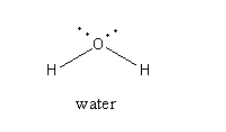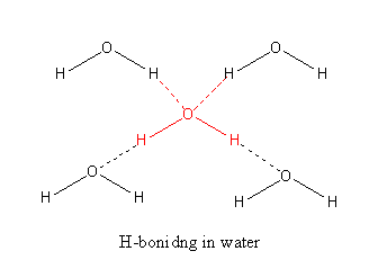
Maximum number of hydrogen bonds formed by a water molecule are:
A. 1
B. 2
C. 3
D. 4
Answer
552.9k+ views
Hint: For hydrogen bonding, hydrogen should be attached with an electronegative atom. In a water molecule, two hydrogen atoms and one oxygen atom are present. The oxygen atom has two lone pairs. When hydrogen gets bonded between two electronegative atoms, the bonding is known as a hydrogen bond.
Complete Step by step answer: The electrostatic attraction between hydrogen and the most electronegative elements of the second row is known as hydrogen bonding. The second-row element involved in hydrogen bonding are nitrogen, oxygen and fluorine.
The water has hydrogen, bonded with oxygen, so it can form hydrogen bonding. The structure of the water is as follows:

The hydrogen bonding in water is shown as follows:

The red colour bonds show the number of hydrogen bonds formed by one water molecule.
One water molecule has two hydrogen atoms which can be bonded with the oxygen of another molecule so, two hydrogen bonds are formed by hydrogen atoms. The oxygen has two lone pairs which can be donated to form two other hydrogen bonds, so a water molecule can form four hydrogen bonds.
So, the maximum number of hydrogen bonds formed by a water molecule are$4$.
Therefore, option (D) $4$ is correct.
Note: The hydrogen bonding is of two types. Intramolecular and intermolecular. Intramolecular hydrogen bonding is found between the groups within the molecule. Intermolecular hydrogen bonding is found between two groups of two molecules. Intramolecular hydrogen bonding is more stable than intermolecular hydrogen bonding. On adding a non-polar solvent the intermolecular hydrogen bonding breaks. The addition of non-polar solvent does not affect intramolecular hydrogen bonding.
Complete Step by step answer: The electrostatic attraction between hydrogen and the most electronegative elements of the second row is known as hydrogen bonding. The second-row element involved in hydrogen bonding are nitrogen, oxygen and fluorine.
The water has hydrogen, bonded with oxygen, so it can form hydrogen bonding. The structure of the water is as follows:

The hydrogen bonding in water is shown as follows:

The red colour bonds show the number of hydrogen bonds formed by one water molecule.
One water molecule has two hydrogen atoms which can be bonded with the oxygen of another molecule so, two hydrogen bonds are formed by hydrogen atoms. The oxygen has two lone pairs which can be donated to form two other hydrogen bonds, so a water molecule can form four hydrogen bonds.
So, the maximum number of hydrogen bonds formed by a water molecule are$4$.
Therefore, option (D) $4$ is correct.
Note: The hydrogen bonding is of two types. Intramolecular and intermolecular. Intramolecular hydrogen bonding is found between the groups within the molecule. Intermolecular hydrogen bonding is found between two groups of two molecules. Intramolecular hydrogen bonding is more stable than intermolecular hydrogen bonding. On adding a non-polar solvent the intermolecular hydrogen bonding breaks. The addition of non-polar solvent does not affect intramolecular hydrogen bonding.
Recently Updated Pages
Master Class 12 Business Studies: Engaging Questions & Answers for Success

Master Class 12 Economics: Engaging Questions & Answers for Success

Master Class 12 English: Engaging Questions & Answers for Success

Master Class 12 Maths: Engaging Questions & Answers for Success

Master Class 12 Social Science: Engaging Questions & Answers for Success

Master Class 12 Chemistry: Engaging Questions & Answers for Success

Trending doubts
What is meant by exothermic and endothermic reactions class 11 chemistry CBSE

Which animal has three hearts class 11 biology CBSE

10 examples of friction in our daily life

One Metric ton is equal to kg A 10000 B 1000 C 100 class 11 physics CBSE

1 Quintal is equal to a 110 kg b 10 kg c 100kg d 1000 class 11 physics CBSE

Difference Between Prokaryotic Cells and Eukaryotic Cells




